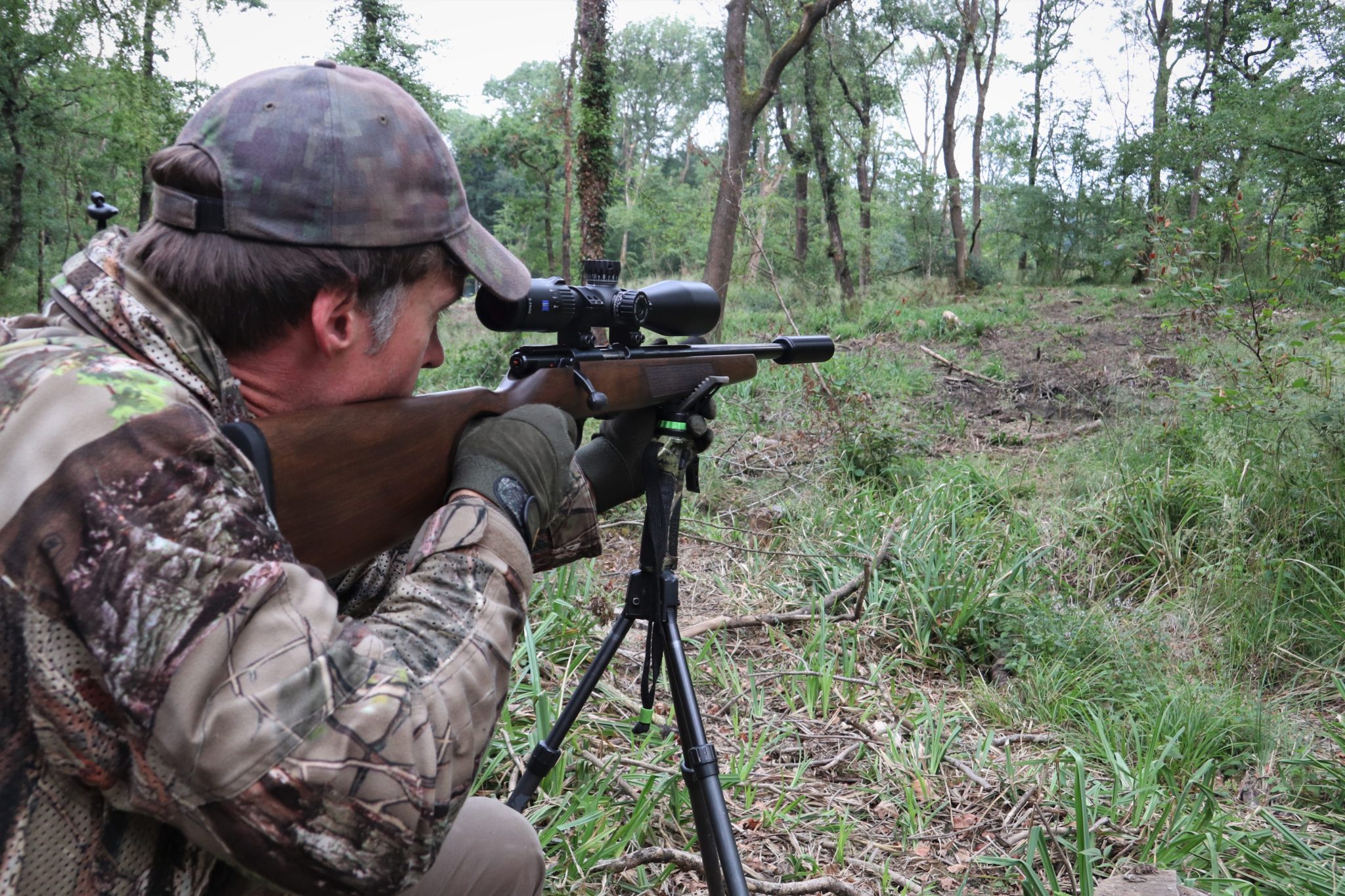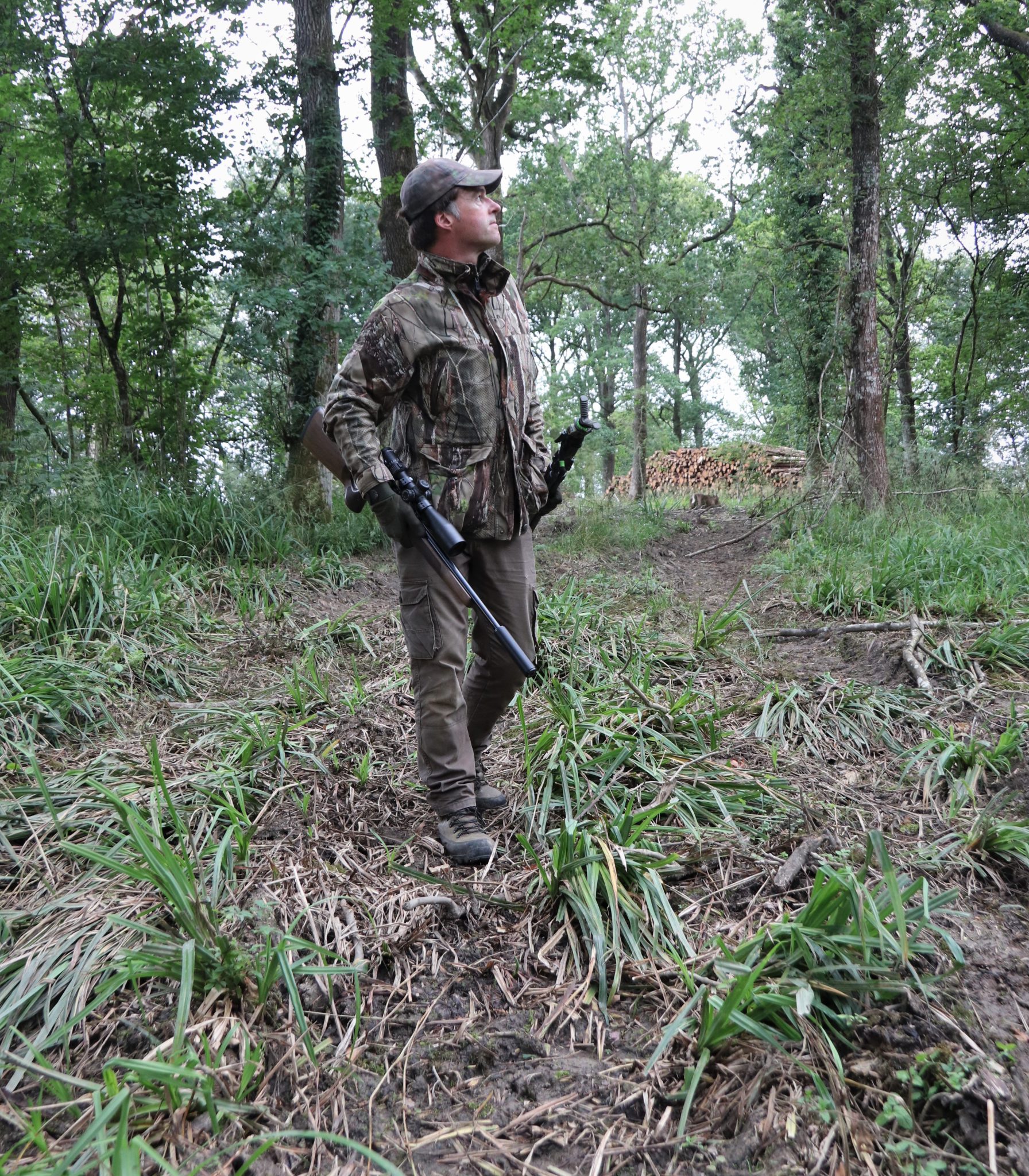Win CENS ProFlex DX5 earplugs worth £1,149 – enter here
Zeiss Conquest V4 review – Mat Manning puts flagship riflescope to the test
 After spotting a squirrel that offers a safe shot on the deck, Mat nestles into the sticks to steady his aim.
After spotting a squirrel that offers a safe shot on the deck, Mat nestles into the sticks to steady his aim.
Zeiss has an enviable reputation for being able to deliver riflescopes that boast the performance and refinement you would expect from a German optics giant without the inconvenience of an eye-watering price tag. Knowing that the Conquest V4 range aims to follow in that vein, I couldn’t wait to mount one to my Weihrauch rimfire and put it through its paces.
With prices starting at £895 and stretching to £1,250 for the flagship 6-24×50 ZMOAi-T20 reticle model featured here, the Conquest V4 is not cheap but it still delivers remarkable value for its price point. Look through one and you will see what I mean – brightness and sharpness of image are better than on some scopes costing twice as much.
Weighing in at 690g and measuring 365mm, I would describe the 6-24×50 model as leaning towards the big end of mid-sized scopes – it is chunky but doesn’t look or feel out of place on my rather traditional-looking HW66. Made in Japan, the scope is also available in 4-16×44 and 4-16×50 formats. Add a remarkable choice of reticle configurations, and it’s safe to say that most scenarios are covered.
Tough, properly water-proofed and nitrogen-purged to stop them from fogging up, these scopes are made for unsympathetic field use, and that was my main intention for this one. But I needed to familiarise myself with it first, so I had a session on the range before letting rip on the increasingly abundant local pest population.
Reticle choice is a big selling point, and the Conquest V4 range offers everything from a conventional duplex (known as the 60) to some very sophisticated layouts. The second focal plane review scope had the ZMOAi-T20 reticle, which falls into the latter group. This arrangement features MOA markers and numbers as well as an array of dots in the bottom section. It sounds complicated and, although I prefer a simpler reticle, the elements are so fine that all those aiming points manage not to look confusingly cluttered.

After spotting a squirrel that offers a safe shot on the deck, Mat nestles into the sticks to steady his aim.
I must confess that I have never felt the need to know the exact mathematical value of each aim-off point (life is just too short) but the various markers on the vertical line were useful when applying hold-over to compensate for the fall of my 40-grain subsonic ammo. After tackling target cards at 10m spacings working from a 50m zero, I felt pretty confident of being able to whack anything the size of a rabbit’s head out to 70m – shooting from a rested position, that is.
For those of you who take a close interest in the technical intricacies of their scopes, the Conquest V4’s resettable windage and elevation turrets are exposed and each positive click adjusts point of impact by ¼ MOA. The windage turret pulls up for fast adjustment and snaps back down to lock in position. The elevation turret, which does not need to be lifted to turn, has 80 MOA travel and a handy rotation scale indicator. It is also equipped with Zeiss’s Ballistic Turret, which enables you to set exactly where it stops winding, so you can dial-in for different ranges and always be assured of an exact return to your set zero.
The inner dial on the left-hand turret serves as the parallax adjustment wheel and turns very smoothly with just the right amount of torque. It is not marked for distance; a factor which will annoy some shooters while pleasing those who prefer to add their own precisely calibrated markers. On the plus-side, it parallaxes right down to just 10 metres, which makes this scope a serious option for airgun shooters who want to splash out on something a little better than the norm.
Feeling confident with the new setup, my first port of call after the range session was a woodland permission that has been ravaged as a result of ash dieback. For the past few months, contractors have been busy with their chainsaws removing the infected trees, which make up a large proportion of the woodland. The owners will soon be replanting the extensive gaps with other species, which will make the control of rabbits and grey squirrels more important than ever. Both these pests have a fondness for bark-stripping, which is detrimental to young trees.

Mat’s woodland haunts were looking very different after extensive felling works as a result of ash dieback.
Owing to some frustratingly hot weather, my recent shooting trips had been limited to the last hour or two of daylight. The Conquest V4 boasts a very impressive 90 percent light transmission, thanks to good glass, the six-layer T-Star multi-coating process and a 30mm tube, so I expected it to be comfortable with a spot of dusk shooting.
Plodding through the woods and past stack after stack of felled timber, I scanned ahead for signs of my quarry. It wasn’t long before I spotted a squirrel clambering about in the uppermost branches of an oak. Because of the elevated angle, the shot wasn’t on with the .22 so I left the tree-wrecking rodent in the hope that our paths would cross when I returned with an air rifle.
Weaving along the edge of a softwood plantation, which had also seen some felling to open up rides for the contractors’ heavy machinery, I clocked a more obliging squirrel. This one was on the deck, offering a safe shot in front of an earth bank. The foolish critter sealed its fate by making the mistake of freezing about 35m in front of me. Because the Conquest V4 is a second focal plane scope, I had elected to leave it on 10x magnification so as not to alter my aim-off points. In this instance, and shooting from the support of sticks, it ensured a bright, clear sight picture with sufficient zoom for me to roll the bushy-tail over with a wallop to the bonce. First proper test passed.
Tech specs
Manufacturer: Zeiss
Model: Conquest V4 6-24×50 ZMOAi-T20
Price: From £895 (model tested £1,250)
Length: 365mm
Weight: 690g
Magnification: 6-24x (4-16x also available)
FOV at 100m: 6.3m to 1.6m
Tube Diameter: 30mm
Objective Lens: 50mm (44mm also available)
Reticle: ZMOAi-T20 (other options available)
Turret Adjustment: ¼ MOA
Eye Relief: 90mm
Parallax: side dial down to 10 metres
Features: Ballistic stop turret, illuminated reticle, excellent optical quality
With one in the bag I trundled over to the grassier end of the woods. To my surprise, I didn’t see any more squirrels and the light was really starting to fade by the time I reached what I expected to be the prime bunny zone. The anticipated rabbit-fest failed to materialise as I made my way around what can be a real hotspot. Just as I was beginning to lose hope, twitching ears revealed a buff blob in the gloom to be a solitary bunny, which a quick ping of the rangefinder confirmed to be 54m away.
Peering through the scope, the V4’s impressive light transmission was clearly apparent. The reticle was starting to get lost against the dark background, though, but a twist of the outer dial on the left turret illuminated the central cross with a warm red glow. With the shot just beyond my zero range, I settled the crosshair on the top of the rabbit’s head to give the merest touch of holdover and squeezed through the trigger. The Weihrauch’s muzzle issued a muted “shnack” and the rabbit sprung into a cartwheel as the shot slammed home.
The rapidly-fading light meant that was to be the last shot of the evening but it was enough to confirm the Conquest V4 as a very solid performer. Although this scope has some fancy features, there is a reassuring absence of gimmicky extras, which suggests to me that your spend is going on optical performance rather than unnecessary whistles and bells.
The Zeiss’s final strength came to light during my customary wipe-down before returning my kit to the cabinet. The V4 has very clean, simple lines; devoid of the irritatingly notchy, disjointed construction that you find on overengineered telescopic sights. Consequently, it is very easy to keep clean and I didn’t have to waste much time picking dirt and blood out of grooves before concluding the evening by prepping my squirrel and rabbit for the pot.
Related Articles
Get the latest news delivered direct to your door
Subscribe to Shooting Times & Country
Discover the ultimate companion for field sports enthusiasts with Shooting Times & Country Magazine, the UK’s leading weekly publication that has been at the forefront of shooting culture since 1882. Subscribers gain access to expert tips, comprehensive gear reviews, seasonal advice and a vibrant community of like-minded shooters.
Save on shop price when you subscribe with weekly issues featuring in-depth articles on gundog training, exclusive member offers and access to the digital back issue library. A Shooting Times & Country subscription is more than a magazine, don’t just read about the countryside; immerse yourself in its most authoritative and engaging publication.







